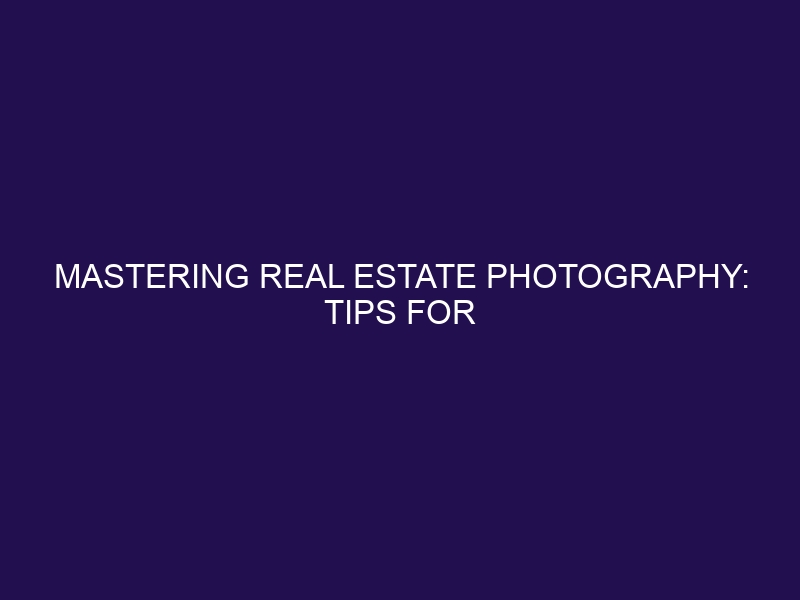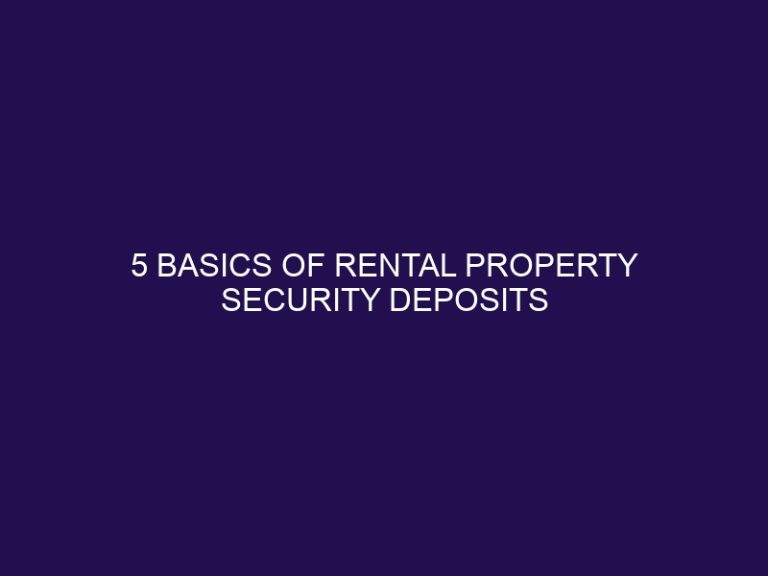Mastering Real Estate Photography: Tips for Showcasing Your Properties
In today’s digital age, real estate photography has become an essential tool for showcasing properties and attracting potential buyers. Whether you are a real estate agent, property owner, or photographer, understanding the intricacies of real estate photography is crucial for effectively capturing the essence of a property and presenting it in the best possible light.
From defining the importance of real estate photography to exploring the gear and equipment needed, as well as the photography techniques and post-production editing, this comprehensive guide will provide you with valuable insights and practical tips to elevate your real estate photography skills. Whether you are a beginner looking to learn the fundamentals or a seasoned professional seeking to refine your techniques, this article is packed with valuable information that will help you take your real estate photography to the next level.
So, let’s delve into the world of real estate photography and unlock the secrets to capturing stunning property images that leave a lasting impression.
Key Takeaways:
Understanding Real Estate Photography
Real estate photography is a specialized field focused on capturing compelling images of residential and commercial properties, showcasing their unique architecture and interior design.
It plays a crucial role in property marketing, serving as a visual asset that can significantly impact a client’s decision-making process. High-quality images have the power to attract potential buyers or renters, often forming the first impression of a property.
Effective lighting and composition are key elements in capturing the essence and character of diverse properties, elevating their appeal in a competitive market.
Definition and Importance
Real estate photography encompasses the art of capturing visually captivating images of properties, playing a pivotal role in presenting properties to potential clients and buyers.
These images are meticulously crafted to showcase the unique features and selling points of a property, and are essential components of any successful marketing strategy. By highlighting the architectural design, interior decor, and surrounding landscapes, real estate photography enables prospective buyers to visualize themselves in the space, igniting their imagination and interest.
In today’s digital age, where online listings and virtual tours are primary sources of property discovery, professionally captured photos significantly influence client engagement and drive higher traffic to listings. Studies have shown that listings with high-quality images tend to attract more views, inquiries, and ultimately lead to faster sales at better prices.
Different Types of Real Estate Photography
Real estate photography encompasses various types, including residential property photography, commercial property photography, architectural photography, interior photography, and aerial photography using drones.
Residential property photography focuses on capturing the unique features and aesthetics of homes, emphasizing curb appeal and interior design. Techniques such as staging, proper lighting, and angle selection are crucial for creating compelling visuals that attract potential buyers.
Commercial property photography involves highlighting the key selling points of commercial real estate, such as retail spaces, office buildings, and industrial properties. It requires a strategic approach to showcase the property’s functionality, location, and surrounding amenities.
Architectural photography is centered around capturing the design, structure, and details of buildings and structures. It involves careful consideration of composition, perspective, and lighting to showcase the architectural elements and convey the intended visual impact.
Interior photography focuses on presenting the interior spaces of properties in an engaging and aesthetically pleasing manner. Attention to detail, use of natural light, and composition play a significant role in capturing the ambiance and character of interior spaces.
Aerial photography using drones allows for capturing stunning aerial views of properties and their surroundings, providing a distinctive and captivating perspective. It offers the opportunity to showcase property features, landscapes, and proximity to amenities from a unique vantage point.
Gear and Equipment for Real Estate Photography
When venturing into real estate photography, having the right gear and equipment is crucial to ensure the quality and visual impact of the captured images.
One of the most important pieces of equipment for real estate photography is a high-quality camera. A full-frame DSLR or mirrorless camera with a wide dynamic range and high megapixel count is ideal for capturing detailed and vibrant property images. Investing in a versatile wide-angle lens is essential to capture the expansive interior spaces of properties while maintaining accurate proportions. A sturdy tripod is essential for achieving sharp, well-composed shots, especially in low light conditions. External flashes are beneficial for illuminating dimly lit areas and reducing harsh shadows. A drone equipped with a high-resolution camera is invaluable for capturing breathtaking aerial views of properties and their surroundings. Utilizing editing tools such as Adobe Lightroom or Capture One is crucial for enhancing and refining the captured images to achieve professional-quality results.
Essential Cameras and Lenses
The choice of camera and lens is fundamental in real estate photography, with popular options including DSLR cameras from Nikon and Canon, known for their superior image quality and versatility.
In terms of capturing stunning property images, these DSLR cameras offer unmatched performance and advanced features that are essential for professional real estate photography. The sensor size, resolution, and dynamic range of these cameras significantly impact the final image quality, ensuring sharpness, clarity, and accurate color reproduction, all crucial for showcasing properties effectively.
Plus the cameras, selecting the right lenses is equally important. Wide-angle lenses, such as the Canon EF 16-35mm and Nikon AF-S 14-24mm, are commonly favored for capturing the spaciousness and architectural details of interior spaces, while telephoto lenses like the Canon EF 70-200mm and Nikon AF-S 70-200mm are ideal for emphasizing exterior features and providing a more compressed perspective on distant objects.
Accessories: Tripods, Flashes, and Remote Triggers
Plus cameras and lenses, accessories such as tripods, flashes, and remote triggers play a crucial role in ensuring stability, optimal lighting, and precise control during real estate photography sessions.
Having a sturdy tripod is essential when capturing interior and exterior shots of properties. It provides the necessary stability to avoid blurry images, especially in low-light conditions. Incorporating flashes allows for effective lighting management, reducing shadows and highlighting the key features of the property. Combining these with remote triggers enables photographers to capture shots from different angles and distances, while maintaining complete control over the camera’s settings and exposure, ensuring high-quality real estate photography.
Special Equipment for Aerial and 360° Photography
For capturing aerial and 360° images, specialized equipment such as drones and panoramic cameras are essential in providing unique perspectives and immersive views of properties.
Drones, equipped with high-resolution cameras and stabilizing technology, enable real estate professionals to capture stunning aerial shots that showcase a property’s surrounding landscapes, neighborhood amenities, and architectural features from a bird’s-eye view. These captivating visuals not only offer potential buyers a comprehensive understanding of the property’s location but also highlight its unique selling points.
Panoramic cameras are utilized to create immersive 360° panoramas that allow viewers to virtually experience the property inside out, providing an enhanced sense of space and layout. The seamless integration of these specialized equipment elevates the presentation and marketability of real estate properties, making them more alluring to prospective buyers.
Preparing for a Real Estate Photoshoot
Effective preparation is key in ensuring successful real estate photoshoots, enabling photographers to deliver exceptional images that meet the expectations of property owners and clients.
Communication with the client is the initial step, where understanding their vision and specific requirements is crucial. Next, assessing the property involves identifying the best angles, highlighting the distinctive features, and addressing any potential challenges. A well-thought lighting setup is essential to capture the property in its best light, often involving a combination of natural and artificial lighting.
Having a well-defined contract is crucial to protect both parties and ensure clarity on deliverables, timelines, and usage rights. Bringing a comprehensive portfolio of previous work not only instills confidence in the client but also showcases the photographer’s capabilities and style.
Creating a Standard Shot List
Developing a standardized shot list is essential in real estate photography, ensuring comprehensive coverage of property features, interior spaces, and exterior views to present a complete visual narrative to potential clients.
To create an effective shot list, start by considering the key elements that need to be showcased – room layout, architectural details, unique features, and attractive outdoor areas. Emphasis should be placed on capturing natural light to highlight the textures and ambience of the property. It’s important to maintain a balance between wide-angle shots and close-ups to portray the spatial flow and intricate details.
Organizing and Preparing Gear
Efficiently organizing and preparing photography gear ahead of real estate shoots is essential in ensuring smooth operations and the ability to adapt to dynamic property conditions and lighting environments.
One crucial aspect of gear organization is to assess the specific requirements of each property, such as size, layout, and lighting, to determine the essential equipment needed. Adaptability is key, as properties can vary significantly, and being equipped for different scenarios ensures that the photographer can capture the best possible images. Having a checklist for gear preparation helps in maintaining readiness and preventing last-minute rushes or oversights that could compromise the quality of the shoot.
Property Walk-Through and Preparation
Conducting a thorough property walk-through and preparation is crucial in identifying unique features, assessing lighting conditions, and ensuring the readiness of the property for an impactful real estate photoshoot.
During the walk-through, it’s important to pay attention to distinctive architectural elements such as vaulted ceilings, custom molding, or panoramic views. These features can significantly enhance the property’s appeal.
Evaluating the natural lighting and its impact on each room is essential for capturing the space in its best form. It’s beneficial to schedule the walk-through at different times of the day to understand the variation in lighting and its effect on the property’s ambience.
Photography Techniques for Real Estate
Mastering photography techniques tailored to real estate settings is essential in capturing the essence of properties, optimizing lighting, staging, and composition, and leveraging innovative perspectives to showcase property features.
In terms of real estate photography, achieving optimal lighting conditions is crucial for highlighting the best features of a property. Professionals often use a combination of natural and artificial light to create a bright, inviting atmosphere.
The art of staging property elements involves arranging furniture, decor, and other highlights to present the space in its best possible light, creating a sense of warmth and inviting ambiance.
The principles of composition play a vital role in creating visually appealing real estate images. Framing shots to showcase the flow and layout of a property, utilizing leading lines to draw the viewer’s eye towards key features, and incorporating diverse perspectives can make a significant difference in capturing the essence of a property.
One innovative tool used in real estate photography is the strategic use of drones to capture aerial views and distinct angles of a property. This allows photographers to provide potential buyers with a comprehensive understanding of the property’s surroundings and layout, ultimately enhancing the visual appeal of property images from diverse viewpoints.
Optimizing Lighting and Ambient Conditions
Optimizing lighting and ambient conditions is fundamental in real estate photography, involving the strategic use of natural and artificial lighting to accentuate property features and create inviting interior and exterior scenes.
In terms of real estate photography, lighting plays a critical role in capturing the essence and character of a property. In interior spaces, it’s essential to harness natural light to create bright and airy atmospheres, while also effectively utilizing artificial lighting to fill in any shadows and highlight key features. Exterior shots require careful consideration of natural light conditions, often involving the use of reflectors or flash units to balance the lighting and bring out the best in the property’s outdoor spaces.
Staging and Composition Tips
Effective staging and composition are pivotal in real estate photography, enabling photographers to create visually appealing and cohesive compositions that highlight the unique architectural and interior elements of properties.
Strategic arrangement of furniture and decor can play a significant role in highlighting the flow and functionality of a space. Leading lines can guide the viewer’s eye through the frame, drawing attention to key features and creating a sense of depth. Visual balance is achieved by carefully positioning elements within the composition, ensuring that each area of the property is showcased harmoniously.
Utilizing Drones and Different Perspectives
Leveraging drones and different perspectives opens new creative opportunities in real estate photography, allowing for captivating aerial views and immersive 360° experiences that showcase properties in a unique and compelling manner.
The use of drones has revolutionized the way real estate properties are captured, presenting an entirely fresh and mesmerizing angle for potential buyers. By providing breathtaking aerial shots, drones offer a distinctive vantage point to present a property’s features and surroundings, demonstrating a scale and proximity that traditional photography struggles to achieve.
The immersive potential of 360° perspectives enables clients to virtually navigate through a property, offering a dynamic and engaging viewing experience. This not only enhances property presentation but also significantly elevates client engagement, allowing them to experience the space as if they were physically present.
Editing and Post-Production
The editing and post-production phase is a critical component of real estate photography, allowing photographers to refine and enhance captured images using software tools such as Adobe Photoshop, Lightroom, Snapseed, and GIMP to achieve professional and visually compelling results.
Professional editing plays a pivotal role in transforming raw property images into captivating visual assets for marketing purposes. Through the use of Adobe Photoshop, photographers can seamlessly remove unwanted objects, adjust colors, and enhance details to create stunning images that showcase the property’s full potential. Moreover, Lightroom provides valuable features for organizing, editing, and presenting photos in a seamless workflow, ensuring consistency and quality across a series of property images.
The application of mobile editing tools such as Snapseed offers flexibility and convenience for real estate photographers, allowing them to make quick but impactful adjustments while on the go. These tools enable the enhancement of specific aspects of an image, such as brightness, contrast, and sharpness, to elevate the overall visual appeal.
Correcting Distortions and Making Adjustments
In the editing process, correcting distortions and making adjustments using software tools such as Adobe Photoshop and Lightroom plays a crucial role in refining property images, ensuring accurate representation and visual appeal.
By utilizing the powerful features of Adobe Photoshop and Lightroom, real estate photographers can effectively correct lens distortions, straighten vertical lines, and adjust the exposure and color balance to achieve a visually pleasing result.
These software applications offer advanced tools for perspective correction, enabling photographers to rectify any misalignments and create a more balanced composition, which is essential for presenting an accurate and appealing representation of the property.
Consistency in Light Temperatures
Maintaining consistency in light temperatures through editing software such as Adobe Photoshop and Lightroom is crucial in ensuring uniformity and visual coherence across property images, creating a harmonious presentation of interior and exterior spaces.
For real estate photography, the consistent light temperatures play a significant role in portraying the property in its best light. Whether capturing the warm glow of a cozy living room or the bright, inviting outdoor spaces, maintaining uniform lighting ensures that the property’s visual appeal remains consistent throughout the images.
Adobe Photoshop and Lightroom are invaluable tools in achieving this visual uniformity. They allow photographers to adjust the color temperature, exposure, and white balance, ensuring that each image seamlessly aligns with the overall visual story of the property.
Utilizing Photo Compositing for Enhanced Results
Photo compositing techniques using software tools such as Adobe Photoshop and GIMP offer the opportunity to create visually enhanced and compelling images by combining multiple exposures and elements to produce stunning final results.
These software applications enable real estate photographers to seamlessly blend various shots with different lighting conditions, resulting in a single, well-exposed image that showcases the property’s features in the best possible light. With Adobe Photoshop and GIMP, professionals can refine and enhance property visuals by creatively compositing elements, such as adding vibrant skies, enhancing landscapes, or removing unwanted objects, thereby elevating the overall appeal and impact of real estate photography.
Conclusion and Additional Resources
In conclusion, real estate photography stands as a dynamic and impactful field, offering the opportunity to showcase properties through visually compelling images, with extensive resources and opportunities for professional growth and recognition across diverse global markets and real estate contexts.
Real estate photography serves as a crucial element in the real estate industry, allowing agents and property sellers to present their listings in the best light possible and attract potential buyers. It plays a significant role not only in enhancing the visual appeal of properties but also in creating a lasting impression on prospective clients.
Professionals in the field of real estate photography can leverage their skills and creativity to capture the unique features and characteristics of properties, whether it be a luxurious villa in Dubai, an elegant penthouse in New York, a charming countryside estate in England, a historical building in Paris, or a modern apartment in the bustling city of London.
Furthermore, real estate photography transcends geographical boundaries, as it is integral to a wide range of cultural contexts, including the distinctive architecture of Dutch homes, the rustic charm of Italian properties, the vibrant colors of Mexican estates, and the picturesque landscapes of the Netherlands.
Summary of Real Estate Photography Tips
Summarizing the essential real estate photography tips and techniques provides a comprehensive reference for photographers, highlighting the nuances and considerations involved in capturing compelling images of residential and commercial properties, enhancing portfolio quality, and aligning pricing strategies with professional standards.
It is imperative for real estate photographers to understand the distinct requirements of residential, commercial, architectural, and interior photography, tailoring their approach to each setting to capture the essence and appeal of the property effectively. Diversity in property types demands adaptability and a keen eye for detail, allowing photographers to showcase unique features and characteristics that resonate with potential buyers or clients.
Optimizing portfolio quality involves employing advanced techniques such as HDR imaging, wide-angle shots, and natural lighting manipulation to elevate the visual allure of properties. By harnessing these methods, photographers can present properties in their best light, attracting greater interest and engagement from prospective customers.
Aligning pricing strategies with professional standards involves comprehensive market research and a thorough understanding of the value proposition that exceptional photography brings to the real estate industry. This necessitates offering competitive yet profitable rates that align with the quality and impact of the photographic services provided.
Related Articles and Further Learning Opportunities
Exploring related articles and learning opportunities in real estate photography offers valuable insights and professional development prospects, with diverse resources available through the National Association Realtors® and within unique real estate markets such as Hawaii, Dubai, New York, London, Paris, and cultural contexts such as Dutch, Italian, Mexican, and Netherlands.
These diverse real estate markets and cultural contexts present a wealth of opportunities for photographers to learn about architectural styles, local preferences, and the unique character of each location.
For instance, in Hawaii, the emphasis on outdoor living spaces and natural beauty can influence the approach to photography, while in Dubai, the focus may be on capturing the ultramodern skyline and luxury properties.
Exploring real estate photography in New York and London can provide insights into shooting urban landscapes and iconic landmarks, whereas the charm of historical architecture in Paris can inspire photographers to capture the romance of the city.
Delving into the cultural nuances of Dutch, Italian, Mexican, and Netherlands real estate markets can offer unique perspectives on design elements, color palettes, and how to effectively showcase properties in different settings.
Frequently Asked Questions
What is real estate photography?
Real estate photography is the practice of taking high-quality photos of properties to showcase them in a visually appealing and appealing way to potential buyers. It is an essential marketing tool for real estate agents and property sellers.
Why is real estate photography important?
Real estate photography is crucial because it is the first impression that potential buyers will have of a property. High-quality photos can make a property more attractive, leading to more interest and potentially higher offers.
What are some tips for taking great real estate photos?
Some tips for taking great real estate photos include using natural light, decluttering and staging the property, using a wide-angle lens to capture more of the space, and editing the photos to enhance their appeal.
What are some common mistakes to avoid in real estate photography?
Some common mistakes to avoid in real estate photography include not using a tripod, not cleaning and decluttering the space, not framing the shots properly, and not editing the photos to enhance their appeal.
How can real estate agents use photography to market their properties?
Real estate agents can use photography to market their properties by including high-quality photos in their online listings, creating virtual tours for potential buyers, and using social media platforms to showcase the properties to a wider audience.
Can professional real estate photographers provide a competitive advantage?
Yes, professional real estate photographers can provide a competitive advantage by using their expertise and equipment to produce stunning photos that can make a property stand out in a crowded market. They can also save time for agents by taking care of the photography aspect, allowing them to focus on other aspects of the sale.







